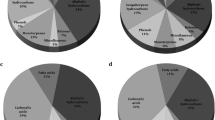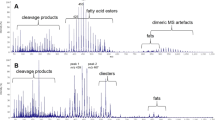Abstract
The uropygial secretions of some bird species contain volatile and semivolatile compounds that are hypothesized to serve as chemical signals. The abundance of secretion components varies with age and season, although these effects have not been investigated in many species. We used solid-phase microextraction headspace sampling and solvent extraction coupled with gas chromatography–mass spectrometry to detect and identify volatile and semivolatile chemical compounds in uropygial secretions of gray catbirds (Dumetella carolinensis). We identified linear and branched saturated carboxylic acids from acetic (C2) through hexacosanoic (C26); linear alcohols from decanol (C10) through docosanol (C22); one aromatic aldehyde; one monounsaturated carboxylic acid; two methyl ketones; and a C28 ester. We tested for the effect of age on signal strength and found that juvenile birds produced greater amounts of volatile C4 through C7 acids and semivolatile C20 through C26 acids, although the variation among individuals was large. Adult birds displayed small concentrations and minimal individual variation among volatile compounds, but produced significantly higher levels of long-chain linear alcohols than juvenile birds. We tested for the effects of season/location by sampling adult catbirds at their Ohio breeding grounds and at their Florida wintering grounds and found that the heaviest carboxylic acids are significantly more abundant in secretions from birds sampled during winter at the Florida site, whereas methyl ketones are more abundant in birds sampled during summer on the Ohio breeding grounds. We observed no effect of sex on semivolatile compounds, but we found a significant effect of sex on levels of carboxylic acids (C4 through C7) for juvenile birds only.




Similar content being viewed by others
References
BOHNET, S., ROGERS, L., SASAKI, G., and KOLATTUKUDY, P. E. 1991. Estradiol induces proliferation of peroxisome-like microbodies and the production of 3-hydroxy fatty acid diesters, the female pheromones, in the uropygial glands of male and female mallards. J. Biol. Chem. 266:9795–9804
BONADONNA, F., MIGUEL, E., GROSBOIS, V., JOUVENTIN, P., and BESSIERE, J. 2007. Individual odor recognition in birds: an endogenous olfactory signature on petrels’ feathers? J. Chem. Ecol. 33: 1819–1829.
CIMPRICH, D. A., and MOORE, F. R. 1995. Gray Catbird (Dumetella carolinensis), in A. Poole, (ed.). The Birds of North America. No. 167. Cornell Lab of Ornithology, Ithaca, New York.
GALVÁN, I., BARBA, E., PICULO, R., CANTÓ, J. L., CORTÉS, V., MONRÓS, J. S., ATIÉNZAR, F., and PROCTOR, H. 2008. Feather mites and birds: an interaction mediated by uropygial gland size? J. Evol. Biol. 21: 133–144
GIRAUDEAU, M., DUVAL, C., GUILLON, N., BRETAGNOLLE, V., GUTIERREZ, C., and HEEB, P. 2010. Effects of access to preen gland secretions on mallard plumage. Naturwissenschaften 97: 577–581.
GRIFFITHS, R., DOUBLE, M. C., ORR, K., and DAWSON, R. J. G. 1998. A DNA test to sex most birds. Mol. Ecol. 7: 1071–1075.
HAGELIN, J. C., and JONES, I. L. 2007. Bird odors and other chemical substances: a defense mechanism or overlooked mode of intraspecific communication? Auk 124: 741–761.
HARIBAL, M., DHONDT, A., and RODRIGUEZ, E. 2009. Diversity in chemical compositions of preen gland secretions of tropical birds. Biochem. Syst. Ecol. 37: 80–90.
HWANG, Y. S., KRAMER, W. L., and MULLA, M. S. 1980. Oviposition attractants and repellents of mosquitoes: Isolation and identification of oviposition repellents for Culex mosquitoes. J. Chem. Ecol. 6: 71–80.
HWANG, Y., SCHULTZ, G. W., AXELROD, H., KRAMER, W. L., and MULLA, M. S. 1982. Ovipositional repellency of fatty acids and their derivatives against Culex and Aedes mosquitoes. Environ. Entomol. 11: 223–226.
HWANG, Y., SCHULTZ, G. W., and MULLA, M. S. 1984. Structure-activity relationship of unsaturated fatty acids as mosquito ovipositional repellents. J. Chem. Ecol. 10: 145–151.
JACOB, J. and ZISWILER, V. 1982. The uropygial gland, pp. 199–324, in D. S. Farner, J. R. King, and K. C. Parkes, (eds.). Avian Biology, Vol. 6. Academic Press, New York.
KARLSSON, A. C., JENSEN, P., ELGLAND, M., LAUR, K., FYRNER, T., KONRADSSON, P., and LASKA, M. 2010. Red junglefowl have individual body odors. J. Exp. Biol. 213: 1619–1624.
KOLATTUKUDY, P. E., and SAWAYA, W. N. 1974. Age dependent structural changes in the diol esters of uropygial glands of chicken. Lipids 9:290–292
KRAMER, W. L., HWANG, Y., and MULLA, M. S. 1980. Oviposition repellents of mosquitoes: Negative responses elicited by lower aliphatic carboxylic acids. J. Chem. Ecol. 6: 415–424.
MARDON, J., SAUNDERS, S. M., ANDERSON, M. J., COUCHOUX, C., and BONADONNA, F. 2010. Species, gender, and identity: cracking petrels’ sociochemical code. Chem. Senses 35: 309–321.
MARTÍN-VIVALDI, M., PEÑA, A., PERALTA-SÁNCHEZ, J. M., SÁNCHEZ, L., ANANOU, S., RUIZ-RODRÍGUEZ, M., and SOLER, J. J., 2010. Antimicrobial chemicals in hoopoe preen secretions are produced by symbiotic bacteria. Proc. R. Soc. B 277:123–130.
MONTALTI, D., GUTIÉRREZ, A. M., REBOREDO, G., and SALIBIÁN, A. 2005. The chemical composition of the uropygial gland secretion of rock dove Columba livia. Comp. Biochem. Physiol. A 140: 275–279.
PYLE, P. 1997. Identification Guide to the North American Birds. Slate Creek Press, Bolinas, CA.
RENEERKENS, J., PIERSMA, T., and DAMSTÉ, J. S. S. 2002. Sandpipers (Scolopacidae) switch from monoester to diester preen waxes during courtship and incubation, but why? Proc. R. Soc. Lond. B 269: 2135–2139.
RENEERKENS, J., PIERSMA, T., and DAMSTÉ, J. S. S. 2005. Switch to diester preen waxes may reduce avian nest predation by mammalian predators using olfactory cues. J. Exp. Biol. 208:4199–4202.
RENEERKENS, J., ALMEIDA, J. B., LANK, D. B., JUKEMA, J., LANCTOT, R. B., MORRISON, R. I. G., RIJPSTRA, W. I. C., SCHAMEL, D., SCHEKKERMAN, H., DAMSTÉ, J. S. S., TOMKOVICH, P. S., TRACY, D. M., TULP, I., and PIERSMA, T. 2007. Parental role division predicts avian preen wax cycles. Ibis 149: 721–729.
SANDILANDS, V., POWELL, K., KEELING, L., and SAVORY. C. J. 2004. Preen gland function in layer fowls: Factors affecting preen oil fatty acid composition. Br. Poul. Sci. 45:109–115.
SOINI, H. A., SCHROCK, S. E., BRUCE, K. E., WIESLER, D., KETTERSON, E. D., and NOVOTNY, M. V. 2007. Seasonal variation in volatile compound profiles of preen gland secretions of the dark-eyed junco (Junco hyemalis). J. Chem. Ecol. 33:183–198.
WHELAN, R. J., LEVIN, T. C., OWEN, J. C., and GARVIN, M. C. 2010. Short-chain carboxylic acids from gray catbird (Dumetella carolinensis) uropygial secretions vary with testosterone levels and photoperiod. Comp. Biochem. Physiol. B 156:183–188.
WHITTAKER, D. J., REICHARD, D. G., DAPPER, A. L., and KETTERSON, E. D. 2009. Behavioral responses of nesting female dark-eyed juncos Junco hyemalis to hetero- and conspecific passerine preen oils. J. Avian Biol. 40:579–583.
WHITTAKER, D. J., SOINI, H. A., ATWELL, J. W., HOLLARS, C., NOVOTNY, M. V., and KETTERSON, E. D. 2010. Songbird chemosignals: volatile compounds in preen gland secretions vary among individuals, sexes, and populations. Behav. Ecol. 21:608–614.
YAO, M., ROSENFELD, J., ATTRIDGE, S. SIDHU, S., AKSENOV, V. and ROLLO, C. D. 2009. The ancient chemistry of avoiding risks of predation and disease. Evol. Biol. 36:267–281.
ZHANG, J., SUN, L., and ZUO, M. 2009. Uropygial gland volatiles may code for olfactory information about sex, individual, and species in Bengalese finches Lonchura striata. Curr. Zoology 55: 357–365.
ZHANG, J. X., WEI, W., ZHANG, J., and YANG, W. 2010. Uropygial gland-secreted alkanols contribute to olfactory sex signals in budgerigars. Chem. Senses 35: 375–382.
Author information
Authors and Affiliations
Corresponding author
Rights and permissions
About this article
Cite this article
Shaw, C.L., Rutter, J.E., Austin, A.L. et al. Volatile and Semivolatile Compounds in Gray Catbird Uropygial Secretions Vary with Age and Between Breeding and Wintering Grounds. J Chem Ecol 37, 329–339 (2011). https://doi.org/10.1007/s10886-011-9931-6
Received:
Revised:
Accepted:
Published:
Issue Date:
DOI: https://doi.org/10.1007/s10886-011-9931-6




